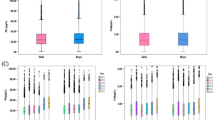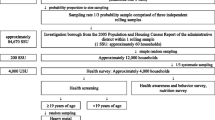Abstract
Objective: Elderly people are particularly vulnerable to environmental pollutants due to the effects of aging. Pb and Hg are heavy metals that can cause elevated environmental pollution and harm humans. With this study, we aimed at collecting Pb and Hg blood concentrations in Koreans over 50 years old in the general population and comparing different factors that might affect these concentrations.
Methods: For this study, we selected a total of 6,681 adults who participated in the 1st and 2nd stage (during 2009-2011 and 2012-2014, respectively) of the Korean National Environmental Health Survey (KoNEHS).
Results: The proportion of women over 65 years old slightly increased from the 1st to 2nd the stage; meanwhile, the Pb and Hg blood concentrations increased and remained stable, respectively. Heavy metals blood concentrations were relatively high compared to those registered in other countries. During the 1st stage, Pb concentration was related to gender (i.e., higher concentrations in males), drinking habits, residential areas (i.e., higher concentrations in the presence of air pollution monitoring stations), and smoking. During the 2nd stage, we did not consider the residential area but the residential type (i.e., higher concentrations living in the detached house). Influential factors affecting Hg concentration during the 1st stage were gender (i.e., higher concentrations in males), fish intake (i.e., daily or weekly), age (i.e., between 50-64 years), seafood consumption during the week (i.e., yes). During the 2nd stage, the body mass index (BMI) (i.e., eventual obesity) was also considered.
Conclusion: The concentration of heavy metals in the blood of adult Koreans was estimated to be higher than in other countries. Hence, exposure levels should be reduced by continuous monitoring and the identification of pollution sources. The outcomes of the present research will ultimately contribute to the prevention of heavy metals exposure, while considering the elderly population characteristics.
Similar content being viewed by others
References
2019 Population and Housing Census, http://kostat.go.kr/portal/eng/pressReleases/1/index.board?bmode=read&aSeq=370994 (2018).
UN world population prospects: the 2015 revision, http://esa.un.org/unpd/wpp/publications/files/key_findings_wpp_2015.pdf (2015).
Future Population Estimates: 2015-2065, http://kostat.go.kr/portal/korea/kor_nw/2/2/6/index.board?bmode=read&bSeq=&aSeq=357935&pageNo=1&row Num=10&navCount=10&currPg=&sTarget=title&sTxt= (2016).
An aging world 2015: International population reports, http://www.census.gov/content/dam/Census/library/publications/2016/.../p95-16-1.pdf (2016).
Hong, Y. C. et al. Comprehensive evaluation for environmental exposures and health effects in elderly population. Korea Ministry of Environment (2015).
Lee, S., Shin, M., Hong, Y. C. & Kim, J. H. Temporal variability of blood Pb, Hg, and cadmium levels in elderly panel study (2008-2014). Int. J. Hyg. Environ. Health.220, 407–414 (2017).
Jin, H. Y. & Cho, S. Estimation of Socio-economic costs of illness due to blood concentration of heavy metals in Koreans among the public. Health and Social Welfare Review.36, 508–536 (2016).
Kwon, S. Y. et al. Erythrophagocytosis of Pb-Exposed Erythrocytes by Renal Tubular Cells: Possible Role in Pb-Induced Nephrotoxicity. Environ. Health Perspect.123, 120–127 (2015).
Muldoon, S. B., Cauley, J. A., Kuller, L. H., Scott, J. & Rohay, J. Lifestyle and sociodemographic factors as determinants of blood Pb levels in elderly women. Am. J. Epidemiol.139, 599–608 (1994).
Lee, J. Y. et al. The association of heavy metal of blood and serum in the Alzheimer’s diseases. Toxicol. Res.28, 93–98 (2012).
Agency for Toxic Substances and Disease Registry (ATSDR). Toxicological Profile for lead (Update). Atlanta, GA: U.S. Department of Public Health and Human Services, Public Health Service (2007).
US NIH. NTP monograph: health effects of low-level Pb. National Toxicological Program (2012).
Wilhelm, M., Heinzow, B., Angerer, J. & Schulz, C. Reassessment of critical Pb effects by the German biomonitoring commission results in suspension of the human biomonitoring values (HBM I and HBM II) for Pb in blood of children and adults. Int. J. Hyg. Environ. Health.213, 265–269 (2010).
EFSA Panel on contaminants in Food Chain. Scientific opinion on Pb in food. EFSA J.8, 1570 (2010).
Lanphear, B. P. et al. Low-level environmental Pb exposure and children's intellectual function: an international pooled analysis. Environ. Health Perspect.113, 894–899 (2005).
Gambelunghe, A. et al. Low-level exposure to Pb, blood pressure, and hypertension in a population-based cohort. Environ. Res.149, 157–163 (2016).
Jarup, L. Hazards of heavy metal contamination. Br. Med. Bull.68, 167–182 (2003).
Harada M. Minamata Disease: Methylmercury Poisoning in Japan Caused by Environmental Pollution. Crit. Rev. Toxicol.25, 1–24 (1995).
Pathak, S. K. & Bhowmik, M. K. The chronic toxicity of inorganic mercury in goats: clinical signs, toxicopathological changes and residual concentrations. Vet. Res. Commun.22, 131–138 (1998).
Aschner, M. & Aschner, J. L. Mercury neurotoxicity: mechanisms of blood-brain barrier transport. Neurosci. Biobehav. Rev.14, 169–176 (1990).
Mergler, D. et al. Methylmercury exposure and health effects in humans: A worldwide concern. Ambio.36, 3–11 (2007).
Brownawell, A. M. et al. The potential adverse health effects of dental amalgam. Toxicol. Rev.24, 1–10 (2005).
Kim, J. H., Kim, D. S. & Son, B. Mercury exposure monitoring for Korean schoolchildren: I. Influence of socioeconomic and demographic variables. Toxicol. Environ. Health Sci.3, 232-238 (December 2011).
Kim, D. S., Kim, G. B., Kang T. & Ahn, S. Total and methyl mercury in maternal and cord blood of pregnant women in Korea. Toxicol. Environ. Health Sci.3, 254–257 (2011).
Esteban, M. & Castaño, A. Non-invasive matrices in human biomonitoring: A review. Environ. Int.35, 438- 449 (2009).
WHO regional office for Europe. Human biomonitoring: facts and figures. Copenhagen (2015).
Fontaine, J. et al. Re-evaluation of blood Hg, Pb and cadmium concentrations in the Inuit population of Nunavik (Québec): a cross-sectional study. Environ. Health7, 25 (2008).
Choi, W. et al. Exposure to environmental chemicals among Korean adults-updates from the second Korean National Environmental Health Survey (2012-2014). Int. J. Hyg. Environ. Health.220, 29–35 (2017).
Park, C. et al. Associations between urinary phthalate metabolites and bisphenol A levels, and serum thyroid hormones among the Korean adult population - Korean National Environmental Health Survey (KoNEHS) 2012- 2014. Sci. Total Environ.584-585, 950–975 (2017).
Park, C. et al. Early snapshot on exposure to environmental chemicals among Korean adults-results of the first Korean National Environmental Health Survey (2009-2011). Int. J. Hyg. Environ. Health219, 398–404 (2016).
Bæcklund, M. et al. Variation in Blood Concentrations of Cadmium and Lead in the Elderly. Environ. Res.80, 222–230 (1999).
Friberg, L. & Vahter, M. Assessment of exposure to lead and cadmium through biological monitoring: Results of a UNEP/WHO global study. Environ. Res.30, 95–128 1983).
Silbergeld, E. K., Schwartz, J. & Mahaffey, K. Lead and osteoporosis: mobilization of lead from bone in postmenopausal women. Environ. Res.47, 79–94 (1988).
Muldoon, S. B. et al. Effects of blood lead levels on cognitive function of older women. Neuroepidemiology.15, 62–72 (1996).
The Asia-Pacific Perspective. Redefining Obesity and its Treatment. Sydney: Health Communications (2000).
Korean Endocrine Society; Korean Society for the Study of Obesity. Management of obesity, 2010 recommendation. Endocrinol Metab.25, 301–304 (2010).
CDC (Centers for Disease Control Prevention) in Fourth National Report on Human Exposure to Environmental Chemicals, Updated Tables (National Centerfor Environmental Health, Division of Laboratory Sciences, Atlanta (2017).
Health Canada. Fourth report on Human Biomonitoring of Environmental Chemicals in Canada: Results of the Canadian Health Measures Survey Cycle 4 (2014-2015) (2017).
Human-Biomonitoring (HBM) values for blood and/or urine, http://www.umweltbundesamt.de/sites/default/files/medien/377/bilder/dateien/tabelle_hbm-werte_engl.pdf (2016).
Kim, N. S. & Lee, B. K. National estimates of blood lead, cadmium, and mercury levels in the Korean general adult population. Int. Arch. Occup. Environ. Health84, 53–63 (2011).
Dixon, S. L. et al. Exposure of U.S. Children to Residential Dust Lead, 1999-2004: I. Housing and Demographic Factors. Environ. Health Perspecti.117, 461–467 (2009).
U.S. EPA. Identification of Dangerous Levels of Lead. Final Rule. 40 CFR 745. Fed Reg. 66, 1206 (2001).
U.S. EPA. Lead; Renovation, Repair and Painting. Final Rule. 40 CFR Part 745. Fed Reg. 73, 21692. (2008).
U.S. HUD. Guidelines for the Evaluation and Control of Lead-Based Paint Hazards in Housing 1539-LPB. Washington, DC: U.S. Department of Housing and Urban Development (1995).
U.S. HUD. Final Report. Washington, DC: U.S. Department of Housing and Urban Development; 2004. [accessed 29 September 2008]. Evaluation of the HUD Lead-Based Paint Hazard Control Grant Program. Available: http://www.centerforhealthyhousing.org/HUD_National_Evaluation_Final_Report.pdf.
Acknowledgments
We would like to thank the National Institute of Environmental Research in Korea for providing the KoNEHS data.
Author information
Authors and Affiliations
Corresponding author
Ethics declarations
The KoNEHS data are openly published, with the approval of the Research Ethics Committee of the National Institute of Environmental Research in Korea. Thus, ethical approval was not required for this study.
Additional information
Conflict of Interest
The authors declare that there is no conflict of interest. Author Wookhee Choi declares that she has no conflicts of interest. Author Ryoungme Ahn declares that she has no conflicts of interest. Author Jae Hyoun Kim declares that he has no conflicts of interest.
Rights and permissions
About this article
Cite this article
Choi, W., Ahn, R. & Kim, J.H. Influential Factors on Blood Pb and Hg Concentrations in Koreans over 50 Years Old: Data Analysis of the 1st (2009-2011) and 2nd (2012-2014) KoNEHS. Toxicol. Environ. Health Sci. 11, 295–304 (2019). https://doi.org/10.1007/s13530-019-0416-2
Received:
Revised:
Accepted:
Published:
Issue Date:
DOI: https://doi.org/10.1007/s13530-019-0416-2




